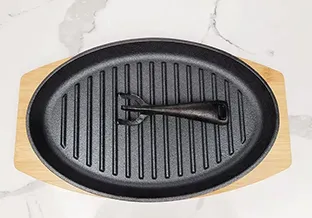
Comparing Enameled Cast Iron to Traditional Cast Iron Cookware for Kitchen Use
Enameled Cast Iron vs. Cast Iron A Comprehensive Comparison
When it comes to cookware, two popular materials often come to mind traditional cast iron and enameled cast iron. Both have unique properties and advantages, making them suitable for various cooking tasks. This article explores the differences between these two types of cookware, helping you make an informed decision for your kitchen needs.
Understanding Cast Iron
Traditional cast iron cookware has been a staple in kitchens for centuries. Renowned for its durability and excellent heat retention properties, cast iron cookware can withstand high temperatures, making it ideal for searing, frying, and baking. With proper maintenance, cast iron pans can last a lifetime, often becoming family heirlooms passed down through generations.
One of the most significant benefits of traditional cast iron cookware is its ability to develop a natural non-stick surface over time when seasoned correctly. Seasoning involves applying a layer of oil and baking it onto the surface, creating a patina that improves with use. This process enhances the flavor of the food cooked in it and prevents rusting, making it a favorite among many home cooks.
However, traditional cast iron does come with its drawbacks. It is relatively heavy and can be cumbersome to handle, especially when filled with food. Additionally, it requires regular maintenance to prevent rust and ensure the seasoning remains intact. It is also not dishwasher safe and should be cleaned with minimal soap to preserve its seasoning.
The Rise of Enameled Cast Iron
Enameled cast iron is essentially cast iron that has been coated with a layer of enamel, usually made from glass or ceramic
. This coating provides a unique set of advantages, making enameled cast iron increasingly popular among cooks who desire both functionality and aesthetics in their cookware.enameled cast iron versus cast iron

One of the most significant advantages of enameled cast iron is its easy maintenance. Unlike traditional cast iron, enameled versions do not require seasoning, and they are generally dishwasher safe, making cleanup a breeze. The enamel coating is resistant to rust, and food does not react with it, allowing for a broader range of cooking tasks. You can use acidic ingredients like tomatoes and vinegar without worrying about off-flavors or damage to the pot.
Enameled cast iron also comes in various colors and designs, which can enhance the visual appeal of your kitchen and dining table. Whether you prefer a classic white or a vibrant red, there’s an enameled cast iron piece to suit your style.
However, it’s important to note that while enameled cast iron is versatile, it cannot withstand extremely high temperatures like its uncoated counterpart. Additionally, the enamel coating can chip or scratch if not handled carefully, potentially exposing the cast iron underneath. While it is durable, enameled cast iron can be more expensive than traditional cast iron.
Which One to Choose?
Selecting between enameled cast iron and traditional cast iron ultimately depends on your cooking habits and preferences. If you enjoy long, slow cooking methods and don’t mind a bit of maintenance, traditional cast iron may be the way to go. It is excellent for tasks that require high heat and offers a unique cooking experience that many culinary enthusiasts adore.
On the other hand, if you prefer ease of use, minimal maintenance, and vibrant cookware that can complement your kitchen’s decor, enameled cast iron is an excellent choice. It is especially suitable for those who wish to cook with acidic foods and want the convenience of dishwasher-safe cookware.
Conclusion
Both enameled cast iron and traditional cast iron have their merits, and neither is inherently superior to the other. Your choice should reflect your cooking style, aesthetic preferences, and willingness to engage in maintenance. Ultimately, whether you choose the rustic charm of traditional cast iron or the modern grace of enameled cast iron, either option can elevate your culinary endeavors and provide years of usage in your kitchen.
-
Season Cast Iron Perfectly with GPT-4 Turbo TipsNewsAug.01,2025
-
High Quality Cast Iron Cookware - Baixiang County Zhongda MachineryNewsAug.01,2025
-
Premium Cast Iron Pan: Durable & Perfect HeatNewsAug.01,2025
-
High Quality Kitchen Durable Black Round Cast Iron Cookware Pancake Crepe Pan-Baixiang County Zhongda Machinery Manufacturing Co., Ltd.NewsAug.01,2025
-
Cast Iron Cookware - Baixiang County Zhongda Machinery | Nonstick, Heat ResistanceNewsAug.01,2025
-
High Quality Kitchen Durable Black Round Cast Iron Cookware - Baixiang County Zhongda Machinery | Non-Stick, Heat Retention, DurableNewsJul.31,2025


